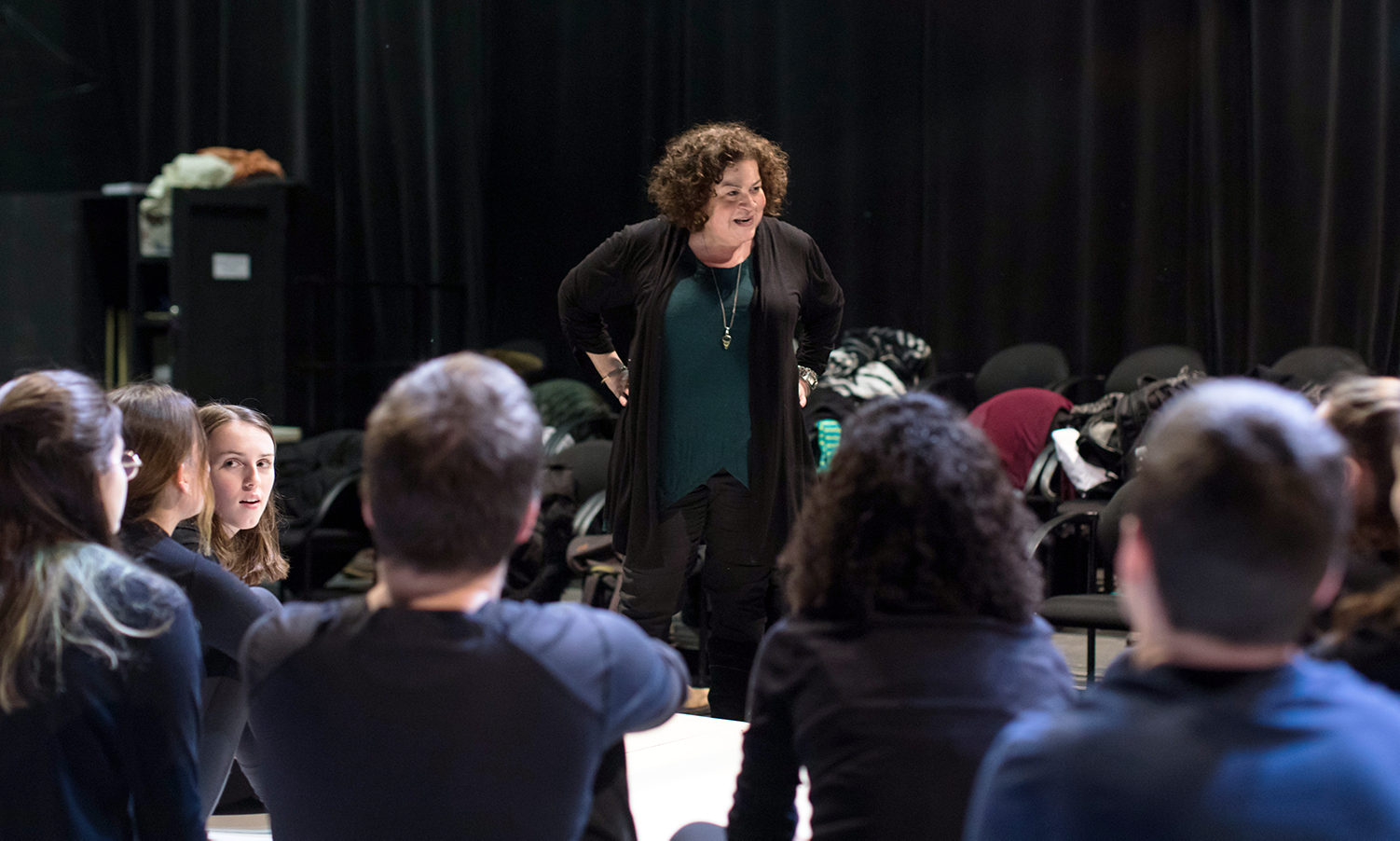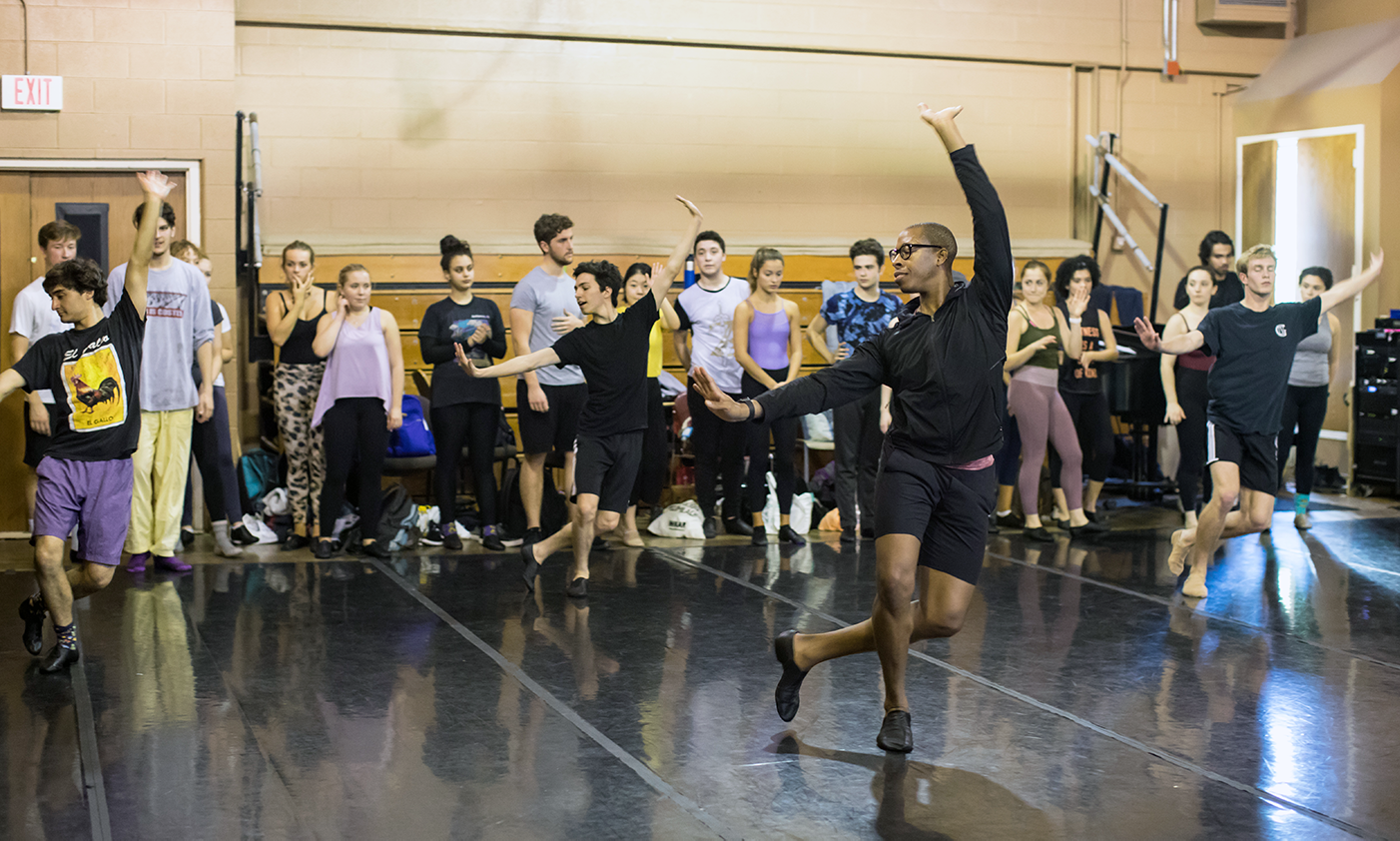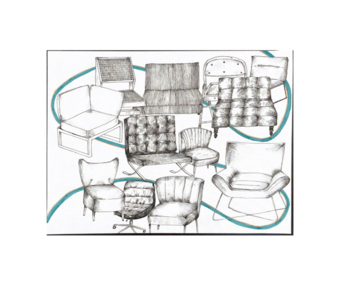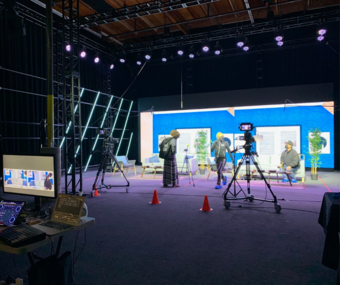David Catlin, ensemble member at Chicago’s Lookingglass Theatre and head of the undergraduate acting program at Northwestern, notes that great drama is predicated on obstacles, on “characters who feel detached, distant, isolated, and alone as an uncertain world changes around them.” When students log into a synchronous digitally taught course, they gain options to curate locales other than a studio, which in Catlin’s opinion could enhance online scene work. A course could be based on gathering oral testimony about what is happening now, discussing it online, and turning it into a live performance when students return to campus. Alternately, students could focus on monologue work, and classes could incorporate guest teachers or casting agents—joining in by Zoom—to reflect and advise. Other ideas, he mentions, would be for classes to emphasize table work, actors-as-dramaturgs, storytelling skills, and developing stand-up routines.
Joel Valentín-Martínez, assistant professor and head of the dance program, acknowledges the challenges of properly guiding students—especially novice dancers—to stretch, generate warmth, and prepare to move safely when teaching online. Experienced students are better equipped to respond to verbal suggestions, yet in classes based on a mixed genre of techniques (which is the norm here) demonstration is still needed. Instructors can demonstrate on camera, as in the classroom, but can they adequately watch twenty thumbnail live feeds to ensure fidelity to form and interpretive acumen, as well as safety for bodies trying things out at home, in dorms, or heaven knows where else? (And do students scattered far and wide have suitable spaces in which to move?)
Creative composition classes for experienced dancers can embrace postmodern approaches to using found space—“rooftops, bathrooms, kitchens, outdoors, and stairways that liberate composition from the studio,” he lists—that interpret a set of verbal or written instructions for playback during meeting times. This could be a boon, but in all cases the emphasis on process, figuring out and verbalizing learning, requires mutual investment in the circumstances.
How does one teach dance and acting—quintessentially embodied forms dependent on human-to-human observation and whole-body involvement—when no one is in a room together?
Cindy Gold, professor of acting, is preparing for the last segment of a three-year sequence of acting courses that culminate in scene study of Chekhov. There is already rapport, trust, and a strong sense of ensemble in the group. In preparation for each scene, students will have to mark-up a text indicating their close analysis and hand this in for feedback from the instructor. But in contrast to teaching in a conventional classroom, this spring students will be encouraged to share their texts with each other using a tool such as Google Docs, laying open their prep process for general discussion. But what does it mean to take the next step and put the work “on its feet”? How can two students demonstrate a two-hander scene when they are in different states?
Gold, who also has a thriving career on stage and screen, notes that over the past year 50 percent of her own auditions have been online, whether for TV, stage, or film, and in or out of town. “I predict there will be more and more,” she says, so she is embracing the future by exploring the digital classroom. In scene work, Zoom can function like a split screen, the whole class watching two actors intensively observe each other. This can bring new awareness, when observed again in replays, and support Gold’s consistent message about holistic observation in partner work. She anticipates discussions about how to optimize students’ scene work, for example trying scenes as three-quarter body shots and as close-ups to hone her students’ critical eyes for conveying subtext and then discussing the options and implications with great specificity. “This can be very valuable for actors to do for a couple of months,” Gold says. “It can be an extremely interesting adventure in understanding technique like never before.”
The last class before spring break, Roger Ellis had planned to explore Mary Overlie’s Viewpoints Theory and Practice in his physically demanding course on movement for the stage. Students were used to working together, but as new strictures to cope with the pandemic unfolded in real time, Ellis opted for everyone to meet virtually. While this ensured social distancing and avoided oft-touched surfaces in a contact-oriented movement course, Ellis also turned it into a way to utilize grounding exercises centered on presence. Helping students to respond to moment is integral to Ellis’s approach:
What I find most meaningful about teaching improvisation is that it is not only a theatre technique but a life skill. Improvisation helps participants cultivate the courage it takes to remain present when one cannot control the outcome. To be an artist is to be resilient, adaptable, and flexible, while also committing to one’s holistic wellness. Although the circumstances surrounding this moment are truly dreadful, we have an opportunity as educators to turn this into a constructive teaching moment.
The fifteen students were at first skeptical of the online experiment, then embraced the opportunity. Ellis saw them “dial-up awareness of their physical-emotional landscape,” which, he notes, “brought that awareness into physical theatre exercises in composition, storytelling, point of view, and improvisation.” Anxiety melted into gleeful experimentation as the class explored what the environment afforded.
Although the circumstances are truly dreadful, we have an opportunity as educators to turn this into a constructive teaching moment.
For Ellis, this opened up a slate of interesting questions:
- How can presence be embodied, transmitted, and perceived across cyberspace?
- How is the observer-participant relationship complicated, deepened, limited, and/or expanded when mediated by technology?
- How are actors or observers (dis)empowered in this new relationship?
- How can the unexpected infusion of digital technology into traditionally analog experiences drive or inhibit innovation? How can this phenomenon blur the dividing line between mediums like film, dance, and theatre?
- How can online platforms dismantle, enforce, or contextualize traditional power dynamics and hierarchies within the classroom?
- How does teaching in this new context prompt new questions about surveillance, agency, gaze, intimacy, and privacy?
When classes start up again after spring break, Ellis will teach a course on musical theatre performance. But how does one teach acting through song remotely—especially when one’s approach centers on physically driven forms of exploration? And given that nuances of breath, timing, intention, and physical action between the singer and accompanist is essentially a duet, how will using recorded accompaniment alter the experience? Ellis—who draws influence from Deborah Black, who teaches Viewpoints courses online, as well as Sheri Sanders, whose Rock the Audition coursework also involves coaching singers online—says he is energized to dive headlong into such a challenge.
Teaching performing arts online is feasible when learning objectives drive decisions, but the mediating technologies must be utilized intelligently. For example, coming back to the staple of acting classes—scene work—presents opportunities for students to garner insight into how they calibrate expressiveness for screen acting. At the same time, looking intently into a laptop screen could run counter to the goal of shedding self-consciousness. “The screen is essentially a mirror,” Catlin notes, and it may be important to find a way to “veil one’s own image” through a technological or psychological toggle switch. This process might help aspiring actors accelerate their progress toward freedom from self-censorship as well as the discipline of constructive self-awareness.
These plans demonstrate that though lesson modalities need to shift, curriculum is not abandoned. Are there limits to what can be tried online? Can circus arts or partnered dance be taught this way? Maybe… not? Yet theatre training, it turns out, can thrive when obstacles are broached as opportunities.













Comments
The article is just the start of the conversation—we want to know what you think about this subject, too! HowlRound is a space for knowledge-sharing, and we welcome spirited, thoughtful, and on-topic dialogue. Find our full comments policy here
Roger Ellis has reminded me of several additional resources:
Scene Study Emergency Pack
Includes new or adapted plays by John Patrick Shanley, Jeremy Kareken, Vern Thiessen, and others which are all new or adapted for a remote setting! These plays are free to download and use in online classrooms. More playwrights are working on plays for this project, and a second volume will follow soon! If playwrights are interested in contributing a short play (either new or adapted for a remote setting), instructions on how to do so are also on the website.
Paula Vogel’s Bake-off
A bake-off is a quickly written exercise on an assigned theme with assigned elements that folks do within a 48 hour period of time. This page also includes Vogel’s COVID Bake Off. Could also be a useful prompt for devising.
#ViralMonologues
The company, 24 Hour Plays is holding a virtual 24 hour play festival on Instagram. Writers and actors collaborate on a series of monologues written for and performed in domestic places of shelter—in each round, new plays are released every 15 minutes. I watched a few interesting pieces here that explore the distinctions between home, shelter, and family--biological, chosen, or by necessity, which might resonate with students during this time.
Tips and Techniques for Online Performance
Here are some self-tape tips from the folks behind Stranded: Views from Quarantine